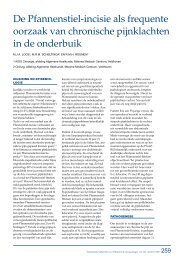Surgical management of chronic inguinal pain syndromes - Liespijn
Surgical management of chronic inguinal pain syndromes - Liespijn
Surgical management of chronic inguinal pain syndromes - Liespijn
You also want an ePaper? Increase the reach of your titles
YUMPU automatically turns print PDFs into web optimized ePapers that Google loves.
DISCUSSIONIn the present study a neurectomy <strong>of</strong> the ilio<strong>inguinal</strong> and/ or iliohypogastric nerve(s)provided good to excellent results in nearly three quarters <strong>of</strong> all women suffering fromPfannenstiel-induced neuralgic <strong>pain</strong>. Apart from a few case reports 16-21 , literature isscarce. One study described a large number <strong>of</strong> neurectomies including 36 that werePfannenstiel-induced with similar favourable results 22 . In another recent study all sevenreported patients were <strong>pain</strong> free following a neurectomy 23 . Neurectomy <strong>of</strong> the genitalbranch <strong>of</strong> the genit<strong>of</strong>emoral nerve is unnecessary. There is increasing evidence that aselective neurectomy constitutes a safe and effective treatment for postoperativePfannenstiel-related neuralgia in most patients.Using the presented algorithm, total <strong>pain</strong> relief occurred in five cases after administeringa local nerve block omitting the need for neurectomy 12 . The anaesthetic agentprobably pushes the <strong>pain</strong> threshold back to its normal level. This finding further stressesthe conditional need for using diagnostic nerve blocks as they appear to have therapeuticvalue as well.Inguinal neuralgia caused <strong>pain</strong> during sexual activities in over half <strong>of</strong> the women,possibly due to compressed nerve tissue during muscle contraction. A neurectomy ortherapeutic nerve block provided intercourse-related <strong>pain</strong> relief in a substantial portion<strong>of</strong> the patients. Remarkably, to the author’s knowledge, this entity has never beenreported in medical literature. Since these forms <strong>of</strong> inconvenience greatly affect quality<strong>of</strong> life, proper attention should be given to these issues. Moreover, <strong>inguinal</strong> neuralgiashould be included into the differential diagnosis <strong>of</strong> dyspareunia as well.Results <strong>of</strong> the present study indicate that surgery was ineffective in a quarter <strong>of</strong> thepatients. Various factors possibly contributing to unsuccessful neurectomy must beconsidered. First <strong>of</strong> all, before proceeding to surgery, <strong>pain</strong> reduction (albeit temporary)after a peripheral nerve block is a ‘sine qua non’. A recent study suggested a treatmentalgorithm using <strong>pain</strong> history and physical examination as main parameters for surgery,omitting diagnostic nerve blocks 23 . In our experience, some patients do not react onnerve blocks, as their central nervous system may be sensitized. These patients sufferfrom ‘central neuropathic <strong>pain</strong>’, and this separate population will not respond to peripheralnerve surgery, leaving only drug therapy (antidepressants, anti-epileptics, gabapentin)as therapeutic measures. Secondly, a neurectomy should probably include all<strong>pain</strong> conducting nerve structures as also promoted for <strong>pain</strong> <strong>syndromes</strong> following groinhernia surgery 24 . Thirdly, <strong>pain</strong> may recur after an initially successful neurectomy orpresent elsewhere on the abdominal wall. Possible explanations involve neuromaformation at the nerve stump, or revelation <strong>of</strong> a previously suppressed non-neuropathic<strong>pain</strong> cause (e.g. periostitis pubis). Moreover, as non-responders differ from respondersin number <strong>of</strong> associated co-morbidities and earlier invasive <strong>pain</strong> treatments, theseaspects may act as denominators for surgical failure. Taking these considerations intoaccount, a positive nerve block followed by a thorough neurectomy in patients with fewrisk factors will likely lead to satisfying surgical results.Which preventive measures can be taken by the surgeon performing the Pfannenstielincision? A solid knowledge <strong>of</strong> neuroanatomy, meticulous tissue dissection, avoidance<strong>of</strong> extreme lateral incision 2 , and prevention <strong>of</strong> suturing beyond the rectus margin willhelp to avoid nerve entrapment. In case <strong>of</strong> immediate severe postoperative <strong>pain</strong>, surgicalexploration <strong>of</strong> the <strong>pain</strong>ful area may be performed without delay as nerve entrapmentby suture material must be excluded. Since nerve entrapment may also occur over timedue to fibrosis, knowledge on clinical presentation and treatment <strong>of</strong> this debilitating<strong>pain</strong> syndrome is warranted.In conclusion, peripheral nerve blocking provides long-term <strong>pain</strong> reduction in someindividuals. An iliohypogastric or ilio<strong>inguinal</strong> nerve neurectomy is a safe and effectiveprocedure in most remaining patients.REFERENCES1 Kisielinski K, Conze J, Murken AH, et al. The Pfannenstiel or so called “bikini cut”: Still effective morethan 100 years after first description. Hernia 2004; 8: 177-1812 Luijendijk RW, Jeekel J, Storm RK, et al. The low transverse Pfannenstiel incision and the prevalence<strong>of</strong> incisional hernia and nerve entrapment. Ann Surg 1997; 225: 365-3693 Tisdale BE, Kapoor A, Hussain A, et al. Intact specimen extraction in laparoscopic nephrectomyprocedures: Pfannenstiel versus expanded port site incisions. Urology 2007; 69: 241-2444 Kessler H, Hohenberger W. Laparoscopic total colectomy for slow-transit constipation. Dis ColonRectum 2005; 48: 860-8615 Loos MJA, Scheltinga MRM, Mulders LGM, Roumen RMH. The ‘Pfannenstiel’ approach as a source<strong>of</strong> <strong>chronic</strong> <strong>pain</strong>. Obstet Gynecol 2008; 111: 839-8466 Hannah ME, Whyte H, Hannah WJ, et al. Maternal outcomes at 2 years after planned cesareansection versus planned vaginal birth for breech presentation at term: the international randomizedterm breach trial. Am J Obstet Gynecol 2004; 191: 917-9277 Nikolajsen L, Sørensen HC, Jensen TS, et al. Chronic <strong>pain</strong> following Caesarean section. ActaAnaesthesiologica Scandinavica 2004; 48: 111-1168 Huikeshoven FJ, Dukel L. De bikini-snede, mooi maar niet altijd zonder pijnlijke gevolgen. NedTijdschr Geneesk 1998; 142: 1481-14839 Mandelkow H, Loeweneck H. The iliohypogastric and ilio<strong>inguinal</strong> nerves. Distribution in theabdominal wall, danger areas in surgical incisions in the <strong>inguinal</strong> and pubic regions and reflectedvisceral <strong>pain</strong> in their dermatomes. Surg Radiol Anat. 1988; 10: 145-14910 Rab M, Ebmer J, Dellon L. Anatomic variability <strong>of</strong> the ilio<strong>inguinal</strong> and genit<strong>of</strong>emoral nerve: implicationsfor the treatment <strong>of</strong> groin <strong>pain</strong>. Plast Reconstr Surg 2001; 108: 1618-162311 Blanco R.G, Parithivell V.S, Shah A.K, Abdominal Wall Endometriomas. Am J Surg 2003; 185: 596-598118 Chapter 8<strong>Surgical</strong> <strong>management</strong> <strong>of</strong> <strong>inguinal</strong> neuralgia after a low transverse Pfannenstiel incision 119





